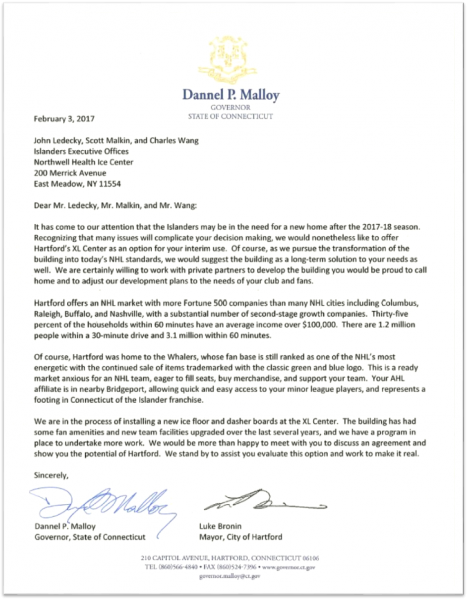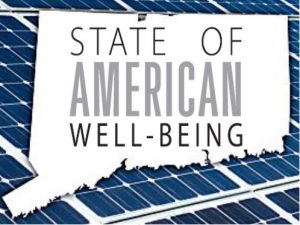Whalers Hartford Attendance 20 Years Ago Exceeds Islanders in Brooklyn
/For Hartford hockey fans of the Whalers vintage, a peek at this year’s National Hockey League (NHL) attendance figures are either demoralizing or encouraging – or both. It has been two decades since the Whalers were uprooted by ownership, replanted in North Carolina and renamed the Hurricanes, and two weeks since Gov. Dannel Malloy and Hartford Mayor Luke Bronin took their first shot at the now Brooklyn-based New York Islanders. Lowest attendance in the NHL this year belongs to the Carolina Hurricanes, at 12,025 through 24 home games, followed at the bottom of the league by the Islanders, averaging 12,829 through 32 home games, as of this week.
Lowest attendance in the NHL this year belongs to the Carolina Hurricanes, at 12,025 through 24 home games, followed at the bottom of the league by the Islanders, averaging 12,829 through 32 home games, as of this week.
Last year, the 2015-16 season, the Hurricanes averaged 12,203 for their 41 home games, last in the league, while the Islanders were third lowest in the NHL at 13,626. Both are lower than the Whalers average attendance in their final season in Hartford, nearly two decades ago.
In comparison, the top teams in the league this year for home attendance are the Chicago Black Hawks, averaging 21,669 and Montreal Canadians, seeing 21,288 per game thus far this year.
In their final season on Long Island at the Nassau Coliseum in 2015-16, the Islanders average home attendance was 15,189, an increase from the immediate previous seasons. The Carolina Hurricanes had the second lowest attendance in the league that year, at 12,594. During the 2012-13 season, the Islanders attendance was the lowest in the 30-team league, at 13,306.
With more than 1,000 obstructed seats in the Barclay Center arena that the Islanders share with the New York Nets in Brooklyn, rumors have circulated since last year of a possible move to a new arena in Queens built for hockey, unlike the Islanders current home, first and foremost a basketball arena. There has been local opposition to that possibility. Recent published reports have also indicated that the Barclay Center and Islanders could part company after the 2018-19 season or a year earlier if the team decides to relocate.
With no official word one way or the other, Connecticut officials are taking their shot, with a possible assist from a $250 million makeover of the XL Center, former home of the Whalers. That proposal must be approved by the state legislature, a tall order at a time when the state budget deficit is approaching $2 billion.
In the Whalers’ final season in Hartford, 1996-97, attendance at the Hartford Civic Center had grown to 87 percent of capacity, with an average attendance of 13,680 per game. Published reports suggest that the average attendance was, in reality, higher than 14,000 per game by 1996-97, but Whalers ownership did not count the skyboxes and coliseum club seating because the revenue streams went to the state, rather than the team. Attendance increased for four consecutive years before management moved the team from Hartford. (To 10,407 in 1993-94, 11,835 in 1994-95, 11,983 in 1995-96 and 13,680 in 1996-97.)
During the team’s tenure in Hartford, average attendance exceeded 14,000 twice – in 1987-88 and 1986-87, when the team ranked 13th in the league in attendance in both seasons.
In recent years, the Islanders have been at or near the bottom of the league in home attendance: 
- 2015-16 28th
- 2014-15 25th
- 2013-14 26th
- 2012-13 30th
- 2011-12 29th
- 2010-11 30th
- 2009-10 29th
Whalers merchandise continues to sell well, despite the team not having played a single game in this century. Whalers merchandise was Reebok's top selling non-current NHL team, according to published reports in 2015. While the company has expanded its lineup to include Whalers logos from different eras, the Hartford Business Journal reported, gear featuring the team's original logo remained the most popular and continues to be offered on the NHL Official Shop website, on multiple websites and in retail locations in the U.S. and Canada.
The Connecticut officials said “this is a ready market anxious for an NHL team, eager to fill seats, buy merchandise, and support your team,” reminding Islanders officials that ““Your AHL affiliate is in nearby Bridgeport, allowing quick and easy access to your minor-league players, and represents a footing in Connecticut of the Islander franchise.”
The NHL has given no indication that it will approve a move out of the New York market, according to NBC Sports, although Commissioner Gary Bettman has said that the teams owners “are reviewing the situation and looking very seriously at what their options are.”
The only statement released by Islanders ownership after receiving the letter last week from Malloy and Bronin said the team does “look forward to another great year of New York Islanders hockey at Barclays Center next season.” No word on what might, or might not, occur after that.



 The Cuban Lyceum of Bridgeport -- Liceo Cubano de Bridgeport- celebrated its 60th year in 2014, the Connecticut Post
The Cuban Lyceum of Bridgeport -- Liceo Cubano de Bridgeport- celebrated its 60th year in 2014, the Connecticut Post 

 The researchers say it’s important to look at the context in which foods are presented as well as the frequency, observing that the people they interviewed rarely noticed that food was mentioned in children’s books, nor what messages were being conveyed, UConn Today reported.
The researchers say it’s important to look at the context in which foods are presented as well as the frequency, observing that the people they interviewed rarely noticed that food was mentioned in children’s books, nor what messages were being conveyed, UConn Today reported.

 Published
Published  Back in 2013, the state Bond Commission approved $1 million in borrowing to help an emergency home repair company move its headquarters from Stamford to Norwalk. The bonding was aimed at assisting the
Back in 2013, the state Bond Commission approved $1 million in borrowing to help an emergency home repair company move its headquarters from Stamford to Norwalk. The bonding was aimed at assisting the  Traffic safety topics being tracked nationwide include: Aggressive Driving, Automated Enforcement/Photo Monitoring, Child Passenger Protection, Distracted Driving, Driver’s Licensing, Impaired Driving, Motorcycle Safety, Pedestrian and Bicycle Safety, School Bus Safety, Seatbelts and Occupant Protection, Senior Drivers Issues, Slow-Medium speed vehicles, Speed Limits, and Teen Driver Issues.
Traffic safety topics being tracked nationwide include: Aggressive Driving, Automated Enforcement/Photo Monitoring, Child Passenger Protection, Distracted Driving, Driver’s Licensing, Impaired Driving, Motorcycle Safety, Pedestrian and Bicycle Safety, School Bus Safety, Seatbelts and Occupant Protection, Senior Drivers Issues, Slow-Medium speed vehicles, Speed Limits, and Teen Driver Issues.


 Throughout my life, I have always wanted to live up to the person my father wanted me to be - indeed, to be the person he wanted to be if circumstances in our country were different, almost 80 years ago.
Throughout my life, I have always wanted to live up to the person my father wanted me to be - indeed, to be the person he wanted to be if circumstances in our country were different, almost 80 years ago.
 In 2016, Connecticut had a Well-Being Index score of 61.7, which is lower than the national Well-Being Index score of 62.1. The report, which is part of the Gallup-Healthways State of American Well-Being series, examines well-being across the nation, including how well-being varies by state and which states lead and lag across the five elements of well-being. They are:
In 2016, Connecticut had a Well-Being Index score of 61.7, which is lower than the national Well-Being Index score of 62.1. The report, which is part of the Gallup-Healthways State of American Well-Being series, examines well-being across the nation, including how well-being varies by state and which states lead and lag across the five elements of well-being. They are:


























